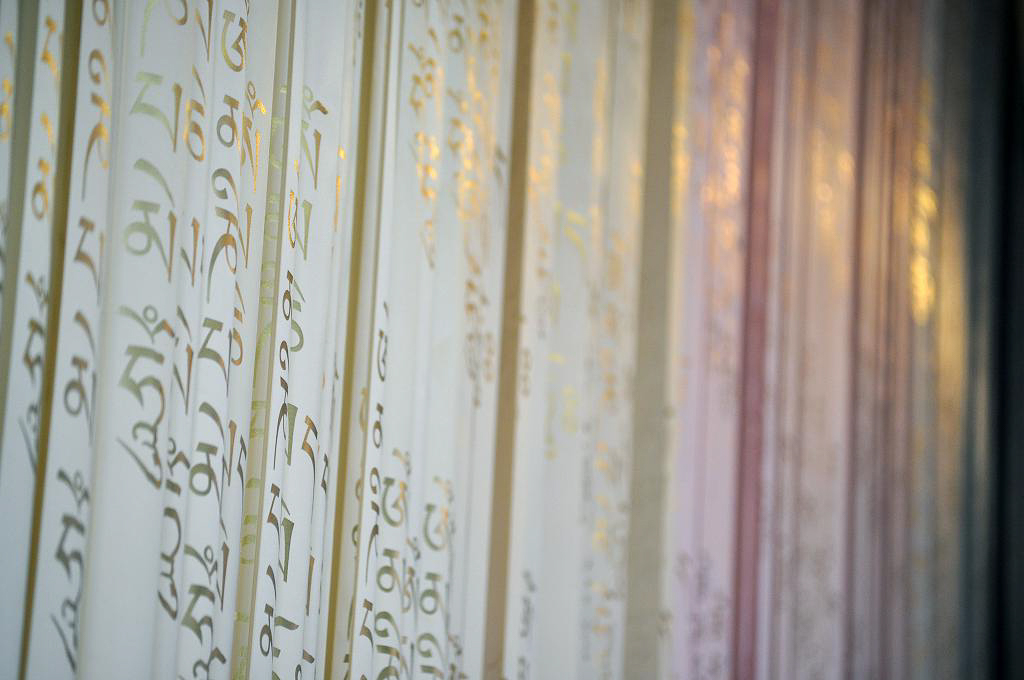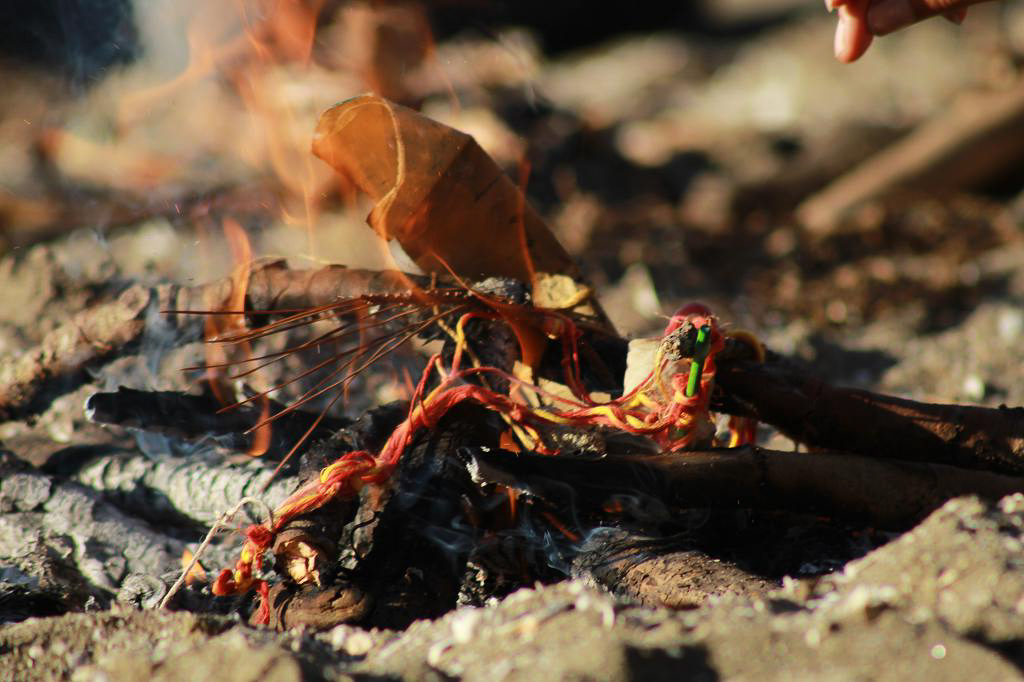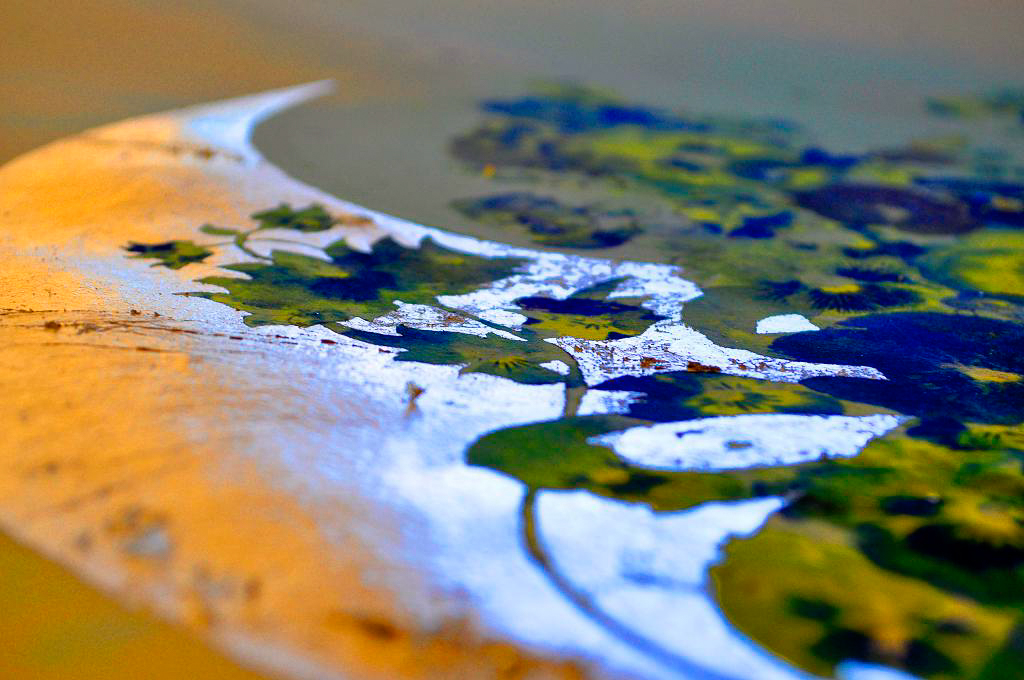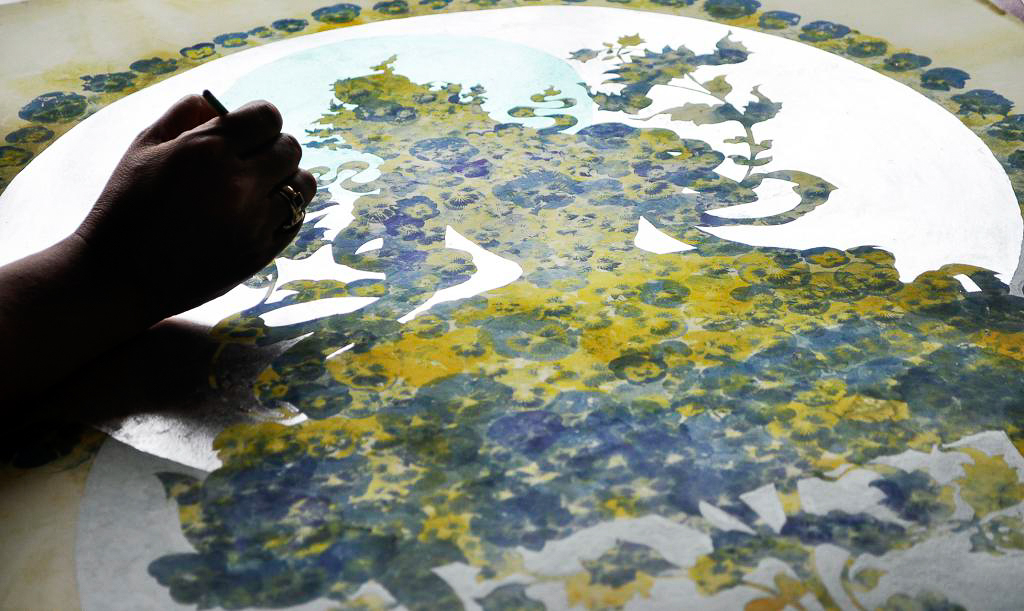Tiffany Singh writes about her installations and performances that draw on spiritual and collective energies.
What binds artworks that span mediums, scale, aesthetics and conceptual discourse? These distinctively different manifestations are bound with intention and the energy of others that enriches the work’s life force, calling these experiences and environments into our realm of being. Here, there is no lone isolation of the studio but a global network of artisans and rural and refugee communities that allow these artworks to emerge to uphold the voices of many. United in social practice methodology, a synergy of people, the energies of many hands, the labour and meditation of time: gathering 50,000 stitches, printing 10,000 mantras, collecting colours from 100,000 visitors, attaching 40,000 sinkers and growing 20,000 flowers. Slow practice, time-based in trust and relationship building, and peer-to-peer structures that stay true to values enable us to rewrite narratives around meaningful cultural exchange.
Art becomes the collective messenger, facilitating contributions that honour tradition yet position ancient knowledge as a contemporary experience. Allowing a shift to take place that quiets the mind and connects the heart, operating beyond duality. Through the use of sight, sound, touch, smell, and taste, these art experiences provide diverse stimuli that can evoke positive emotions and memories, facilitating audiences to explore their experiences, express their emotions and aid their journey through the healing process. It is with this motivation the works are born to be of service, to support, to mediate, to provide a space for us to transcend and engage with the inner spiritual dimension of our own human nature.
With the belief that liberating the gallery and the arts from institutionalised environments enables space for the spiritual dimension to activate the sacred in the experience, the gallery gives way to the temple, the altar, and the open portal to the intuitive space of knowing. As artists, we re-orient the gallery space to a cultural reconstruction of social relations and ancient knowledge systems that integrate into the social sphere through the applications of giving, helping, provoking, enabling, serving, contributing and giving voice. Artmaking. The gallery and spirit meet.
Mediums, ready-made and drawn from the lineage of Duchamp, draw out the quiet impact of colour and the activation of light in kinship with ritual. Metaphysical mediums attune us to a deeper meaning and connection to binding universal forces. These sensual and emotive experiences centre us in our humanness, enabling our multidimensional selves to feel the cohesion of body, mind, and spirit as a catalyst for healing. I explore the counter-narrative as enquiry, yet materials, ethics, collaborations, and processes become offerings.
Works take on the persona of the altar. A place of consecration and sacrifice, a ceremony through objects and materials. In conversation with Dr Yvonne Chan Cashmore from The University of Technology, we discuss the importance of interactive healing environments to foster emotional safety and well-being, spaces and experiences that move us towards stabilising both our brains and our nervous systems. She notes that throughout history, “We have recognized the therapeutic power of the arts and in recent times, positive psychologists have advocated for the integration of arts activities as a means to express gratitude (Owens & Patterson, 2013), enhance positive emotions (Kurtz & Lyubomirsky, 2013) and attain a sense of life’s meaning (Steger et al., 2013)”.
So we pivot towards an art experience that encourages us to trust in the dynamic relationships it generates, both seen and unseen, known and unknown, but felt and acknowledged as an interconnected whole.
The ongoing Doormat Series collaboration with Hmong refugees in Bangkok, Thailand, operates as a social enterprise initiative allowing vulnerable communities of women to establish ethical livelihood opportunities to strengthen their ability to take care of themselves and their families. The embroidery works express identity and amplify their voice by applying childhood inheritances of pattern and technique within contemporary art narratives, allowing matriarchal memories to resurface in new and provocative ways. In response to the pieces produced inside the women-led cottage industry, the upcycled doormats are further embellished by hand, and then quotes from the conversation, such as “What does it mean to make art as women?” are added by machine to exemplify how industrialisation has changed the process of textile production, leading to a loss of culture in many communities, as hands are replaced by machines and generational knowledge is lost.
- Tiffany Singh “Doormat Series ” 2022 equality remain central. image Tiffany Singh
- Tiffany Singh “Doormat Series ” 2022 . image Tiffany Singh Hind Legs Of An Elephant
- Tiffany Singh “Doormat Series ” 2022 . image Tiffany Singh Household Chores
- Tiffany Singh “Doormat Series ” 2022 Womens Practice carries the spirit. image Tiffany Singh
In Om Mani Padme Hum at the Dunedin Public Art Gallery, the meditation of repetition again becomes the practice. It was adorned with fair-trade bells as a commitment to supporting the cottage industry and the ongoing partnership with rural artisan communities in India. This time soft gentle illuminating silver colours in a palette of rainbow pastels harmonious in their relationships. The tonal variations reference the Terra Chakra, the positive flow of energy that grounds us and connects us to the earth Gaia. A Tibetan mantra script gifted from Lharampa Geshe Thupten Wangchen invites the Buddhadharma into the gallery, the practice of Compassion Buddha and recitation of this mantra purifies negative karma and creates a collective space of wellbeing, meditation and prayer.
- Tiffany Singh Om Mani Padme Hum3, 2016I, installation; photo: Tiffany Singh
- Tiffany Singh Om Mani Padme Hum3, 2016I, installation; photo: Tiffany Singh
- Tiffany Singh Om Mani Padme Hum3, 2016I, installation; photo: Tiffany Singh
- Tiffany Singh Om Mani Padme Hum3, 2016I, installation; photo: Tiffany Singh
In 2018, Te Papa Tongarewa, the Museum of Aotearoa New Zealand, commissioned and acquired Total Internal Reflection. Grounded in the science of colour therapy and sound healing, colour again becomes the composer of our individual vibrations as the gallery space becomes reflective of how our frequencies activate each other. Through the different energies and healing properties that colours possess, Total Internal Reflection becomes a therapeutic environment designed to encourage collective participation and inner reflection. Visitors enter a blackened hallway towards a panel of seven illuminated coloured buttons: red, orange, yellow, green, blue, violet and magenta. Colours that correlate to the seven chakras or energy centres. In selecting a colour, the visitor enters a light-flooded room. From the darkness into the light. Rebirth, or an experience akin to standing in the light cast through the stained-glass windows of a cathedral. The colour selected by each visitor feeds into the circuit of the light installation, which changes at the pace of human breath connected to the non-Western healing traditions that incorporate physical movement and breath control, yoga, chi qong, and tai chi that regulate our emotional and physiological states. This collaborative approach invites the visitor to coauthor the work. The collective effort required to fill the room with light is a vital part of the social agenda of the work and prompts individuals to reflect on their own relationships within a larger community.
- TIffany Singh, Total Internal Reflection, 2018, installation; photo: R Hollis
- TIffany Singh, Total Internal Reflection, 2018, installation; photo: R Hollis
- TIffany Singh, Total Internal Reflection, 2018, installation; photo: R Hollis
- TIffany Singh. Total Internal Reflection, 2018, installation; photo: Eve Wereta
- TIffany Singh. Total Internal Reflection, 2018, installation; photo: Eve Wereta
- TIffany Singh. Total Internal Reflection, 2018, installation; photo: Eve Wereta
- TIffany Singh. Total Internal Reflection, 2018, installation; photo: Eve Wereta
Ororangi is a name bestowed by Kaumatua Tautoko Waitaika of Ngati Whatua Orakei meaning “blessings from heaven”. It was commissioned by Arttform in 2021. 40,000 textile pieces map the infinite currents and waves of Pacific identity, Va i Ta. It explored how the temporal and spatial nuances of the vā have shaped Pacific identity from its island origins to the Pacific Islander diaspora in Aotearoa/New Zealand. These themes influence a tactile, visual experience aimed at presenting interventions that reflect Teu le Va: to value, nurture and if necessary, to tidy up the sacred and secular spaces of relationships. Visually the work draws on cultural nuances and Va of island life with materials mimicking the shimmering light of sunset dancing on the ocean, references to fishing and the sharing of resources with an emphasis on collectivity and reciprocity rather than individual accumulation.
The work intends to offer the simplest of tools: light and colour to generate a healing experience offering an antithesis of the grey, stark commercial cityscape. Here, the rainbow of inclusivity acknowledges Oceania people’s ebb and flow, with trills of waves in compound perspectives to mirror aspects of the natural environment and play to our overall eudaemonia. A ray of light, a ray of hope that attunes us to the psychology of nature, digging into the ways we can alter/altar the physical environment that we live in, connectivity through a mass of singular threads operates as a single whole, enabling our lens to shift with each perspective. Ororangi, in her vibrance and monumental scale, allows colour to be felt. Presenting to us our own connection to the sea, the land and the sky above – Moana-nui-a-kiwa, Ranginui and Papatuānuku – the wheel of life – and us, te tangata, the people.
- TIffany Singh, Ororangi, 2022, installation; photo: Laura Forest
- TIffany Singh, Ororangi, 2022, installation; photo: Laura Forest
- TIffany Singh, Ororangi, 2022, installation; photo: Laura Forest
The social practice project “Calling A Circle -He Karanga Pae” manifested at the McCahon Residency 2013 was paired with the gallery installation “Life Is But A Vapour” Te Uru Gallery 2014. This work operated in full spiritual discourse addressing the human experience of time, memory and loss. This cultivated an evolving and public memorial project that facilitated individuals in transforming their relationship with death through conscious and ceremonial acts. The McCahon House residency project Calling a Circle – He Karanga Pae involved a therapeutic process in an intimate studio environment where participants were guided to return to the memories, grief and unconscious trauma stemming from the loss of loved ones. Making hand-crafted memorial strings imbued with their memories, emotions and intentions initiated a transformative spiritual and psychological process of healing, acceptance and release. This delicate spiritual ecology of practice was cultivated from the Pacific ceremonies of death and remembrance and encompasses a commitment to sacred living and the promise of spiritual healing within communities of multiple-faiths situated between both Western and Eastern life worlds.
- Tiffany Singh, Calling A Circle, 2014, Social Practice Installation image; photo: Laura Forest
- Tiffany Singh, Calling A Circle, 2014, Social Practice Installation image; photo: Laura Forest
- Tiffany Singh, Calling A Circle, 2014, Social Practice Installation image; photo: Laura Forest
- Tiffany Singh, Calling A Circle, 2014, Social Practice Installation image; photo: Laura Forest
In the summer of 2016, my collaborator Ella Brewer and I shared the same dream. Called into our consciousness by a powerful sense of service and giving the Shadows of The Awakening series was born. This suite of works provides a contemporary lens on sacred Tibetan images. The collaboration sees the diverse English, Maori, Samoan, and Indian heritage of the artists influence traditional forms, creating a modern interpretation of sacred images from the East. These works are created as meditation aids to help manifest the Buddha’s attributes in devotion to the forms. Each work is unique and was created through the purest and most organic materials. The process of making is a deep commitment to time-based organic ecologies where materials are grown and distilled, mixed from the earth’s pigments, and detailed with pure gold and silver as the materials become offerings to the Buddhas themselves. These works in 2022 were then commissioned by Inner World where each artwork was paired with His Holiness the Dalai Lama’s mantra and voice recording as a sacred offering of mantras and teachings set to music. This project strives to create a sense of safety in times of anxiety and fear, giving people both courage and hope and audio and visual connection to the healing aspects of prayer and meditation.
- Tiffany Singh, Shadows of the awakened, 2021, A3 Image; photo: Tiffany Singh
- Tiffany Singh, Shadows of the awakened, 2021, A3 Image; photo: Tiffany Singh
- Tiffany Singh, Shadows of the awakened, 2021, A3 Image; photo: Tiffany Singh
- Tiffany Singh, Shadows of the awakened, 2021, A3 Image; photo: Tiffany Singh
- Tiffany Singh, Shadows of the awakened, 2021, A3 Image; photo: Tiffany Singh
Through the journey of process I have learnt that the social relations of ritual have a lot to do with resonance and how we relate to each other. My call to arms operates between worlds, seeking bridges between the stars and oceans of those who travelled before us, channelling philosophies of Asia Pacific into my subconsciousness and out into the world through my making, transcending conventional materiality and visuality. We connect to our ancestors. This is our making, our offerings, our collective consciousness. A reciprocity between us as the art experience merges into interactive healing environments that leverage multisensory experiences that honour our lineage, our craft, our positioning of indigeneity not for aesthetics sake, but as the messenger of spirit and well-being acting as a catalyst for emotional regulation and the visibility of our heart, soul and the essence of our humanness.
About Tiffany Singh
Singh’s works are determined within the wider discipline of social practice, which emphasises community-orientated and participation-based work. She approaches her community-orientated projects through the facilitation of spiritual healing processes, both inside and outside of the gallery space. Framed within the objectives of spiritual transformation, Singh’s social practice explores the potentials of unity consciousness, individuation, sacred living and being. In this way, her work extends itself to transcendental living, towards the necessity of spiritual liberation and freedom from suffering. Singh’s work also draws considerable influence from Jungian-like individuation processes; examined through the exploration of myth, archetypes and the cultivation of self-knowledge. Utilising the theological-based and mystical knowledge of her Indic faith (combined Buddhist and Hindu faith), Singh’s work enables her audience to explore sacred living by consciously experiencing the metaphysical components of self, through ceremony and ritual grounded in compassion and self-realisation.





























